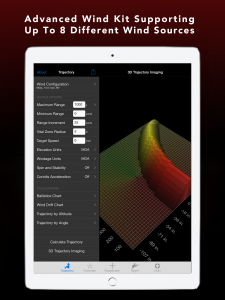On the Range with Ballistic:
Adjusting for The Weather Using Ballistic
 Serious shooters know the wind must be accounted for to make any long-distance shot. And Ballistic has shooters covered here, from standard wind inputs to Ballistics’ own Advanced Wind Kit.
Serious shooters know the wind must be accounted for to make any long-distance shot. And Ballistic has shooters covered here, from standard wind inputs to Ballistics’ own Advanced Wind Kit.
With your Ballistic app, you can input wind speed and direction in a manner of ways. You can use angle inputs (e.g., 90° = crosswind left to right) or the O’clock format (e.g., 3:00 will automatically translate to 90°). Don’t forget headwinds! Ballistic will automatically adjust velocity to account for your headwind calculation.
The Advanced Wind Kit takes full advantage of the JBM ballistics engine’s wind capabilities to allow pro shooters to account for nearly any possible wind scenario. Users can easily and quickly program in even the most complex wind scenarios, for up to eight wind sources. Simply tap to create a new wind zone and then slide it to the appropriate range.
Wind aside, many shooters don’t truly understand the impact other weather and atmospheric factors can also play in putting your shots on target-or way off the mark. According to Curt Vaughn, Head of Product for Ballistic and a long-range shooting competitor, barometric pressure, “Is immensely important in making long-range shots, and needs to be factored into your calculations.”
Generally speaking, the higher the barometric pressure the more drag the air applies to the bullet. For example, Vaughn handloads his own .243 Ackley Improved rounds, firing a Hornady 108 grain ELD Match bullet. At Sea Level, with a temperature of 50 degrees Fahrenheit, and a barometric pressure of 30.00, the bullets in this handload travel approximately 1,400 yards at super-sonic speed before they drop to sub-sonic. But the same load and rifle, with the barometric pressure at 27.00, now has a maximum super-sonic range of 1,550 yards.
Or consider the effect temperature has on your ammunition. Vaughn notes that temperature differences don’t affect the path of the bullet per se. Rather, the air temp impacts how fast your round’s gun powder burns and how much pressure it develops. For example, when Vaughn’s .243 Ackley Improved handload is fired at 20 degrees Fahrenheit, it has a muzzle velocity of 3,175 fps and stays super-sonic out to 1,350 yards. But take that same round and fire it off at 80 degrees? Now, the muzzle velocity is 3,286 fps, and the bullet stays super-sonic out to 1,450 yards.
Huge differences such as these and other weather-related factors can affect the trajectory and down range performance of any bullet. Applications such as Ballistic provide invaluable tools to make these corrections on-the-fly so that serious shooters can make every shot count in any condition.
For more information, please visit ballisticapp.com.

